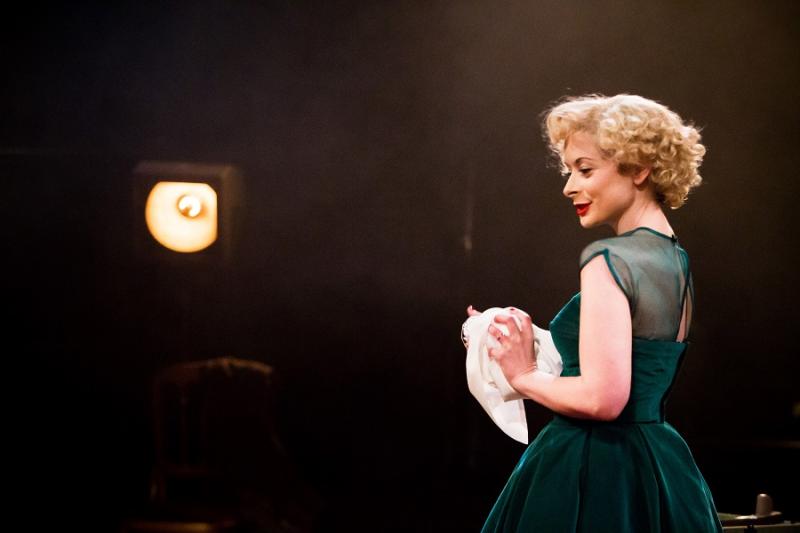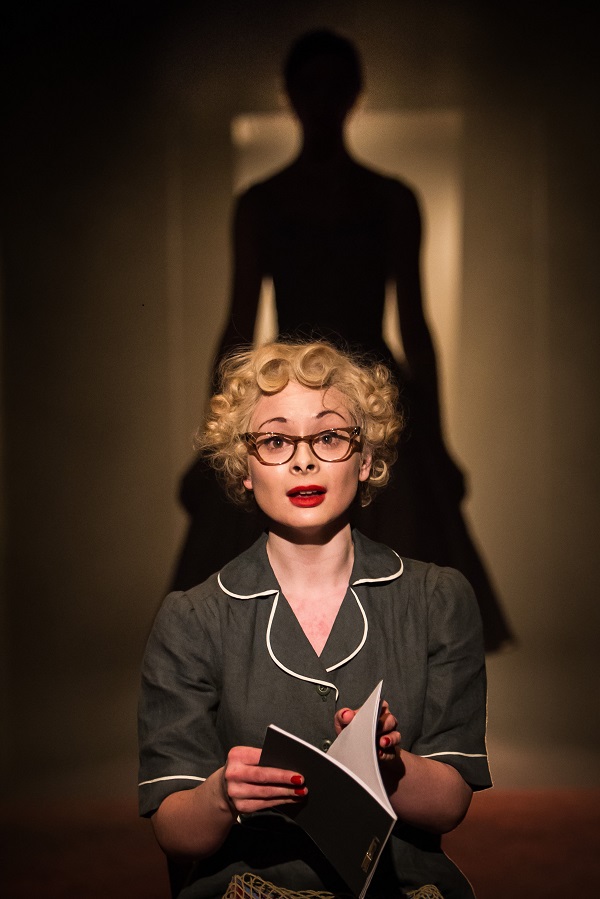Why write about Ruth Ellis? | reviews, news & interviews
Why write about Ruth Ellis?
Why write about Ruth Ellis?
The inspiration behind a new play about the last woman to be hanged in Britain

"Why write about Ruth Ellis?" It’s a question I’ve been asked many times in the run-up to The Thrill of Love and it’s a good one. I’d like to know the answer, too.
Three years ago, I was commissioned by the New Vic Theatre in Newcastle-under-Lyme to write a play which I suspect is some 30 years in the making. I can trace its beginnings to the mid-Eighties, when I was 17 years old and on high-alert for the kind of gritty icons who graced the singles covers of The Smiths. I discovered Ruth Ellis at the cinema, played so vividly by Miranda Richardson in Dance with a Stranger. The film cast a powerful spell, not least because of the screenplay by Shelagh Delaney, whom I already loved for A Taste of Honey. Delaney wrote in a way that no other playwright I knew. Her characters gave a spark to my own ambitions. It was a few years before I wrote a play of my own but a fuse had been lit.
The play seeks to understand more about a complex, enigmatic young woman
Yet Ruth Ellis is no fictional character. She was flesh-and-blood real and her story is true. The bare facts are as follows. A 28-year-old model, nightclub hostess and mother-of-two, she was executed in July 1955 for the murder of her lover, David Blakely. Ruth pleaded not guilty but offered little defence. She was tried and sentenced in a day-and-a-half. Three months after the night of the crime, she was dead. The public outcry was a key factor in the abolition of the death penalty. Ruth Ellis became the last woman to be hanged in Britain and her death was seen as a shocking example of "the medieval savagery of the law".
Ruth also lived on in popular culture. A year after her death, Diana Dors was strongly influenced by her story in Yield to the Night, a film with close similarities to her crime and punishment. Ruth still appears in the tabloids when, every few years, yet more "unseen photos" are unearthed. A Fine Day for a Hanging by Carol Anne Lee, published last year, is the latest and best Ruth Ellis biography. A British "blonde bombshell", her reckless life continues to fascinate, as does her lack of remorse. “It's obvious when I shot him, I intended to kill him,” Ruth tersely told the prosecuting QC. “No further questions,” he replied. But of course, there are.
 Ruth had already left a violent marriage when she met Blakely. His own violence was raised in court but not in the way we’d discuss it today. “He only hit me with his hands and his fists but I bruise very easily,” said Ruth, revealing so much about her sense of self-worth. Neither she nor Blakely were faithful and her motive for murder was seen as sexual jealousy. With the benefit of 60 years' hindsight, that looks very much like the symptom and not the disease. The record (and the play) shows Ruth had suffered at the hands of people never brought to justice. In 1955, domestic violence and sexual exploitation had barely been named.
Ruth had already left a violent marriage when she met Blakely. His own violence was raised in court but not in the way we’d discuss it today. “He only hit me with his hands and his fists but I bruise very easily,” said Ruth, revealing so much about her sense of self-worth. Neither she nor Blakely were faithful and her motive for murder was seen as sexual jealousy. With the benefit of 60 years' hindsight, that looks very much like the symptom and not the disease. The record (and the play) shows Ruth had suffered at the hands of people never brought to justice. In 1955, domestic violence and sexual exploitation had barely been named.
There’s no doubt Ruth Ellis committed a terrible crime. She never denied that herself. She shot Blakely outside of a pub at point-blank range. Four bullets went into his body, a fifth bounced off the pavement, hitting a passer-by in the hand, which didn’t help her defence. The sixth, she may have meant for herself but as Blakely lay dying, she passed the gun to an off-duty policeman who found himself first on the scene. She didn’t resist her arrest or her fate. Many thousands of voices called for a reprieve but not hers.
Researching The Thrill of Love took me to the case-files in the National Archives but the emotional truth was more elusive. Official documents reveal more about the authors than the subject, with her psychiatric reports particularly distressing to read given what we now know about mental health. In reference to her crime, one doctor concludes “an emotionally mature woman would have been prevented from this action by thoughts of her children”. Why write about Ruth Ellis? That judgement seems reason enough.
Ruth Ellis has become a symbol of criminal injustice but in The Thrill of Love she is neither victim, villain or hero. The play seeks to understand more about a complex, enigmatic young woman and the life she lived. With Blakely an off-stage character, the story focuses on Ruth and her fellow hostesses. They would have known her better than anyone yet they are all but silent in the official records. By finding their voice, I felt we may hear Ruth’s, too. Exactly what drove her out with a gun on Easter Sunday 1955 can never fully be known but we still have much to learn from the question.
Explore topics
Share this article
The future of Arts Journalism
You can stop theartsdesk.com closing!
We urgently need financing to survive. Our fundraising drive has thus far raised £49,000 but we need to reach £100,000 or we will be forced to close. Please contribute here: https://gofund.me/c3f6033d
And if you can forward this information to anyone who might assist, we’d be grateful.

Subscribe to theartsdesk.com
Thank you for continuing to read our work on theartsdesk.com. For unlimited access to every article in its entirety, including our archive of more than 15,000 pieces, we're asking for £5 per month or £40 per year. We feel it's a very good deal, and hope you do too.
To take a subscription now simply click here.
And if you're looking for that extra gift for a friend or family member, why not treat them to a theartsdesk.com gift subscription?
more Theatre
 Little Brother, Soho Theatre review - light, bright but emotionally true
This Verity Bargate Award-winning dramedy is entertaining as well as thought provoking
Little Brother, Soho Theatre review - light, bright but emotionally true
This Verity Bargate Award-winning dramedy is entertaining as well as thought provoking
 The Unbelievers, Royal Court Theatre - grimly compelling, powerfully performed
Nick Payne's new play is amongst his best
The Unbelievers, Royal Court Theatre - grimly compelling, powerfully performed
Nick Payne's new play is amongst his best
 The Maids, Donmar Warehouse review - vibrant cast lost in a spectacular-looking fever dream
Kip Williams revises Genet, with little gained in the update except eye-popping visuals
The Maids, Donmar Warehouse review - vibrant cast lost in a spectacular-looking fever dream
Kip Williams revises Genet, with little gained in the update except eye-popping visuals
 Ragdoll, Jermyn Street Theatre review - compelling and emotionally truthful
Katherine Moar returns with a Patty Hearst-inspired follow up to her debut hit 'Farm Hall'
Ragdoll, Jermyn Street Theatre review - compelling and emotionally truthful
Katherine Moar returns with a Patty Hearst-inspired follow up to her debut hit 'Farm Hall'
 Troilus and Cressida, Globe Theatre review - a 'problem play' with added problems
Raucous and carnivalesque, but also ugly and incomprehensible
Troilus and Cressida, Globe Theatre review - a 'problem play' with added problems
Raucous and carnivalesque, but also ugly and incomprehensible
 Clarkston, Trafalgar Theatre review - two lads on a road to nowhere
Netflix star, Joe Locke, is the selling point of a production that needs one
Clarkston, Trafalgar Theatre review - two lads on a road to nowhere
Netflix star, Joe Locke, is the selling point of a production that needs one
 Ghost Stories, Peacock Theatre review - spirited staging but short on scares
Impressive spectacle saves an ageing show in an unsuitable venue
Ghost Stories, Peacock Theatre review - spirited staging but short on scares
Impressive spectacle saves an ageing show in an unsuitable venue
 Hamlet, National Theatre review - turning tragedy to comedy is no joke
Hiran Abeyeskera’s childlike prince falls flat in a mixed production
Hamlet, National Theatre review - turning tragedy to comedy is no joke
Hiran Abeyeskera’s childlike prince falls flat in a mixed production
 Rohtko, Barbican review - postmodern meditation on fake and authentic art is less than the sum of its parts
Łukasz Twarkowski's production dazzles without illuminating
Rohtko, Barbican review - postmodern meditation on fake and authentic art is less than the sum of its parts
Łukasz Twarkowski's production dazzles without illuminating
 Lee, Park Theatre review - Lee Krasner looks back on her life as an artist
Informative and interesting, the play's format limits its potential
Lee, Park Theatre review - Lee Krasner looks back on her life as an artist
Informative and interesting, the play's format limits its potential
 Measure for Measure, RSC, Stratford review - 'problem play' has no problem with relevance
Shakespeare, in this adaptation, is at his most perceptive
Measure for Measure, RSC, Stratford review - 'problem play' has no problem with relevance
Shakespeare, in this adaptation, is at his most perceptive
 The Importance of Being Earnest, Noël Coward Theatre review - dazzling and delightful queer fest
West End transfer of National Theatre hit stars Stephen Fry and Olly Alexander
The Importance of Being Earnest, Noël Coward Theatre review - dazzling and delightful queer fest
West End transfer of National Theatre hit stars Stephen Fry and Olly Alexander

Add comment